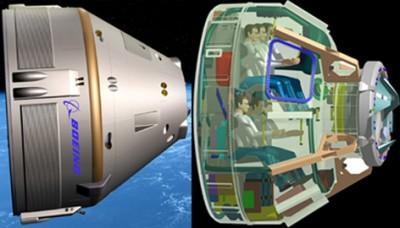Tue, Apr 09, 2013
Designed To Connect Crew Capsule To The Booster
NASA Commercial Crew Program (CCP) partner Boeing has successfully completed a preliminary design review (PDR) of the component that would connect the company's new crew capsule to its rocket. The review is one of six performance milestones Boeing has completed for NASA's Commercial Crew Integrated Capability (CCiCap) initiative, which is intended to make available commercial human spaceflight services for government and commercial customers. The company is on track to complete all 19 of its milestones during CCiCap.

Boeing is one of three U.S. companies NASA is working with during CCiCap to set the stage for a crewed orbital demonstration mission around the middle of the decade. Future development and certification initiatives eventually will lead to the availability of human spaceflight services for NASA to send its astronauts to the International Space Station. The component that was reviewed is called the Launch Vehicle Adapter. The critical structure is being designed by United Launch Alliance (ULA) to join Boeing's Crew Space Transportation-100 (CST-100) (pictured in artist's rendering) spacecraft to ULA's Atlas V rocket, just above the rocket's second stage. "Solid systems engineering integration is critical to the design of a safe system," said Ed Mango, NASA's CCP manager. "Boeing and all of NASA's partner companies are working to build in proper systems integration into their designs. This review with Boeing and their partner ULA was a good review of the current state of these important design
interfaces."
In recent weeks, teams from NASA, Boeing and ULA met at ULA's headquarters in Denver, CO, to assess requirements and capabilities to safely launch people into low-Earth orbit from U.S. soil once again. The PDR was a culmination of early development and preliminary analysis to demonstrate the design is ready to proceed with detailed engineering. "The PDR was an outstanding integrated effort by the Boeing, ULA and NASA teams," said John Mulholland, vice president and program manager of Boeing Commercial Programs. "The ULA design leverages the heritage hardware of the Atlas V to integrate with the CST-100, setting the baseline for us to proceed to wind tunnel testing and the Launch Segment-level PDR in June."
In addition to the Launch Vehicle Adapter PDR, Boeing recently completed two additional CCiCap milestones, including the Engineering Release (ER) 2.0 software release and the Landing and Recovery Ground Systems and Ground Communications design review. The ER 2.0 software release was completed Jan. 25 in Boeing's Avionics and Software Integration Facility Lab in Houston. This test laid the foundation for the software structure to control and fly the spacecraft, as well as communicate with pilots and ground systems.
The landing and recovery ground systems and ground communications design review Jan. 16 to 18 in Titusville, FL, established the baseline plan for equipment and infrastructure needed for CST-100 spacecraft ground communications and landing and recovery operations.
More News
Aero Linx: JAARS Nearly 1.5 billion people, using more than 5,500 languages, do not have a full Bible in their first language. Many of these people live in the most remote parts of>[...]
'Airplane Bounced Twice On The Grass Runway, Resulting In The Nose Wheel Separating From The Airplane...' Analysis: The pilot reported, “upon touchdown, the plane jumped back>[...]
"Burt is best known to the public for his historic designs of SpaceShipOne, Voyager, and GlobalFlyer, but for EAA members and aviation aficionados, his unique concepts began more t>[...]
"Polaris Dawn, the first of the program’s three human spaceflight missions, is targeted to launch to orbit no earlier than summer 2024. During the five-day mission, the crew >[...]
There Are SO Many Ways To Get YOUR Aero-News! It’s been a while since we have reminded everyone about all the ways we offer your daily dose of aviation news on-the-go...so he>[...]
 ANN's Daily Aero-Linx (05.04.24)
ANN's Daily Aero-Linx (05.04.24) NTSB Final Report: Quest Aircraft Co Inc Kodiak 100
NTSB Final Report: Quest Aircraft Co Inc Kodiak 100 Aero-News: Quote of the Day (05.04.24)
Aero-News: Quote of the Day (05.04.24) Aero-News: Quote of the Day (05.05.24)
Aero-News: Quote of the Day (05.05.24) Read/Watch/Listen... ANN Does It All
Read/Watch/Listen... ANN Does It All



